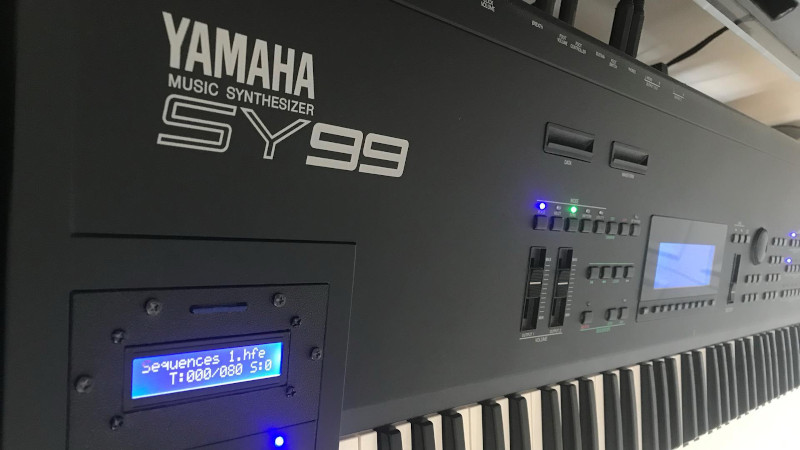Technology marches on at a rapid pace, but in many fields much love remains for older hardware. While still highly capable, there’s often room for improvement thanks to components made available in the intervening years. After longing for his SY-77 synthesiser of the 90s, [Mark] sourced a tired SY-99, the next model up in the line – and set to work on some upgrades.
The SY-99 relied on floppy disks for storage, but the mechanical drives are now difficult to maintain, to say nothing of the unreliability of floppy media. [Mark] installed a SD Card HXC floppy emulator instead, using a Sparkfun SD breakout to neatly install the card slot in the synth’s case. The tired LCD was replaced with a newer model using the same controller, with an LED backlight proving a nice upgrade over the original EL unit.
Additionally, [Mark] realised that there was scope to create his own upgrade modules with off-the-shelf SRAM chips. This proves far cheaper than sourcing second-hand Yamaha stock off eBay, and is readily achievable by anyone with a basic understanding of digital logic. The ICs can be had for a few dollars, versus well over $50 for the original cards – if you can even find them. Some labor is involved, but it’s a lot less painful to the wallet.
[Mark]’s work is a great example of how hardware that was once prohibitively expensive can be given greater functionality at a lower cost thanks to new technology. We’ve seen other synths modded too, like this Korg Monotron. If you’ve been tinkering away in a keyboard yourself, be sure to let us know!
[Thanks to CRJEEA] for the tip]
















great job!
SY99 for life! Debatably the best FM synth that Yamaha ever made. Nice big keyboard, four-channel outputs, and decent onboard FX, decent MIDI implementation, built like a tank (and weighs about that much). Even the ModX is basically just a minor update, IMO, and that’s coming 25 years later.
But the coolest part is that the memory hack linked above ended up as a short-run product: https://www.wohmart.com/sy99-mmb.html (There was a 5 MB gap in the memory map that you can fill up on the cheap these days, and with the hack to the instrument’s OS, you can expand it out waaay bigger than it was ever meant to be. Great work!)
I absolutely love my SY77 – they’re both total sleepers. Looping envelopes man.. why can’t more gear get on board with that. I was shocked and dismayed to find the Motif’s envelope editing no where near as sophisticated as that of these late 80s gems.
Mine’s stock, aside from a new display, and new tact switches (THAT was fun…). Any fun OS hacks for the 77?
Very cool! Excellent work!
Sector 101 makes ram kits https://www.sector101.co.uk/index.html
Nice mods and well documented. However, more amazing is his build on the PAIA Stringz-N-Thingz/Organtua combo. Search under the synthesizer tab on the link’s website
If it was “prohibitively expensive” how did Yamaha make a profit by selling them?
By keeping prices high.
It wasn’t “prohibitively expenseive” to make,just expensive enough that many who lusted after it couodnt afford it back then. Things like floppy drives and cartridges made it more advanced at the time, but added to the higher price.
Some of thise things have filtered down to become commonplace and “cheap”, either directly or workarounds.
So NOT “prohibitively expensive” because after all Yamaha successfully SOLD them. In the timeframe that this unit came out I worked with this and an equivalent Korg unit as well as a DX-7, all bought by someone living on SSI disability; helped him assemble his studio because his vision wasn’t all it should be. Floppy drives made it “more advanced”? That’s so cute.
Here’s the cold hard truth: anything a company can make a profit on by selling it year after year after year and putting out new models of it isn’t “prohibitively expensive”. Because people are buying it. If you can’t afford it you’re not their market.
The original usage of “prohibitive” seems valid, given the audience.
There is an open source softsynth that exists because, according to the old website, the programmer always really wanted a real synth but the expense prohibited him from getting one. Captain Obvious says at least *someone*, and not everyone, has that problem. Nobody ever implied that nobody could ever buy this kind of thing– they implied that *someone* couldn’t buy this kind of thing in the past (when it was new / before the secondhand market had much supply / etc.), and I guess the whole point was “it’s nice that we can have nice things sometimes”, and I choose to agree.
You must be the life of the party. We get it.
“By keeping prices high.”
The SY99 was $4,000 in 1991 dollars: nearly $8000 today.
It wasn’t Yamaha’s most expensive synth, and it was certainly no Fairlight, but it was a heck of a lot of dough. It was a synth for studios and for professionals, and it’s built like it.
They put their best effects engine at the time in there, they tossed in a ton of ROM, they added sample playback capabilities and a decent virtual analog filter section.
They had a ton of design headroom b/c they were aiming at a higher-end niche, and they went wild with it.
Even today, the RCM synthesis, where they take samples and use them as the base waveforms for FM, is unique. It might not be particularly intuitive, but if you design some simple-yet-interesting waveforms and load them in, you get this almost-FM, but spicier, sound. Is this unique to this synth?
I have an sy99 (wow these still sound amazing!) that needs to go as I need space (good electrics but tatty and buttons iffy). Email if interested philsynth@dalesoft.force9.co.uk pickup only near fleet Hampshire.